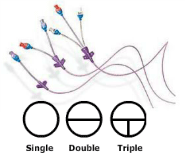PICC characteristics
SIze
- Common manufactured lengths 25 cm to 60 cm
-
French
- French is a measure of outside circumference of the catheter. One increment on the French scale is equal to .33 millimeter, i.e., 3Fr = 1 mm outside diameter (OD).
- Internal diameter (ID) depends on wall thickness and is specific to the device.
- Catheter-to-vein-ratio - the Infusion Nurse Society 2016, Standard 27, Practice Criteria III (PICC), " A venous site in adults where the catheter-to-vein ratio is equal to or less than 45% is recommended".
Physical materials, e.g. polyurethane or medical silicone
Polyurethane |
Silicone |
Advantages
- Polyurethane composition allows thinner walled catheters which yeilds a larger internal diameter and increased flow rate, i.e. (4 Fr. polyurethane internal diameter approx. 0.032” - 4 Fr. silicone, internal diameter approx. 0.024”).
- Easier to insert and advance due to initial stiffness. Softens upon warning to body temperature which may reduce vein trauma
- Easily coated with a variety of specialized coatings.
Less material failures and occlusions
Disadvantages
- More difficult to modify than silicone.
- Initial stiffness may be more damaging to the vessel than softer silicone.
- Polyurethane cannot be autoclaved.
- Check manufacturer recommendations for cleansing and disinfecting; alcohol and acetone can degrade polyurethane
|
Advantages
- Kink resistant when extruded with greater wall thickness.
- Softness, may reduce vein trauma.
- Easily modified
- Can be autoclaved.
Disadvantages
- Slightly textured surface (microscopically) may increase thrombogenesis.
- More difficult to insert and advance due to softness.
- Difficult to coat with specialized coatings.
- Kinking possible in lower durometer/thin walled tubing.
- More venous thromboses in polyurethane catheters.
- Check manufacturer recommendations; Iodine based disinfectants can degrade silicone
|
Vascular Access Catheter TipS (2000) Polyurethane vs. Silicone
http://www.norfolkaccess.com/TiPs/Polyurethane%20and%20SIlicone,%20a%20comparison.pdf |
| Poiseuille's Law. States that the flow (Q) of fluid is related to a number of factors: the viscosity (n) of the fluid, the pressure gradient across the tubing (P), and the length (L) and diameter(r) of the tubing. |
 |
 Single or multiple lumen
Single or multiple lumen
Multiple lumen allow separate infusion for each channel. Total Parenteral nutrition requires a dedicated lumen.
Valved and non-valved
- The valve is a pressure-sensitive slit that remains closed unless fluids are infused (positive pressure: valve opens outward) or blood is withdrawn (negative pressure: valve opens inward). When not in use the closed valve seals fluid inside the catheter preventing blood from entering the catheter. This helps reduce the potential for retrograde blood flow with possible catheter occlusion and reduced risk for air embolism.
- ❉ Catheters without valves will always require a clamp to prevent blood reflux or air entry into the lumen(s).
Gravity infusion/Power-injectable
Pittiruti et al. (2012) report , a standard PICC with a small caliber (typically, 4 to 5 Fr) and length of (30 to 40 cm ), are associated with a high resistance to flow. A single-lumen 4 Fr PICC may achieve a flow rate of 2 to 3 ml/minute (by gravity infusion) and 10 to 11 ml/minute (with pump); the flow rates of a single-lumen 5 Fr PICC are only slightly higher (3 to 4 ml/minute by gravity and 11 to 13 ml/minute with pump). Double-lumen PICCs have worse performance in terms of flow, because increasing the number of lumens reduces the lumen size and further decreases the flow rate.
Power-injectable PICCs - single lumen (3, 4 or 5 Fr), double lumen (4 or 5 Fr) and triple lumen (6 Fr). They all share several features that make them particularly attractive for the ICU setting: low risk of mechanical and hemorrhagic complications at insertion, low risk of CRBSI, high flow (up to 300 ml/minute), easy monitoring of central venous pressure, low risk of lumen obstruction, and safe use for radio-diagnostic procedures. ❉ Always verify the power-injectable lumen.
Anti-thrombogenic/antimicrobial properties
- Hydrophilic surface treatment intended to induce a water-solvate surface layer on the catheter that inhibits biofilm polymer adhesion
- Hydrophobic surface treatment is intended to induce selective protein binding that reduce thrombogenesis, e.g. albumin (Neoh, et al. 2017).
- Antibiotic-impregnated central venous catheters significantly reduced the risk of bloodstream infections compared with standard and heparin central venous catheters (Gilbert, et al. 2020).
References
Gilbert RE, Mok Q, Dwan K, Harron K, Moitt T, Millar M, Ramnarayan P, Tibby SM, Hughes D, Gamble C; CATCH trial investigators. Impregnated central venous catheters for prevention of bloodstream infection in children (the CATCH trial): a randomised controlled trial. Lancet. 2016 Apr 23;387.
https://pubmed.ncbi.nlm.nih.gov/26946925/
Gorski L., Hadaway L., Hagle M.E., McGoldrick M., Orr M., Doellman D. (2016). Infusion Therapy Standards of Practice (Revised 2016). Supplement to Journal of Infusion Nursing, 39(1), 1533-1458.
Neoh, K., Li, M., Kang, E., Chiong, E., & Tambyah, P. (2017). Surface modification strategies for combating catheter-related complications: Recent advances and challenges. Retrieved April 08, 2021, from https://pubs.rsc.org/en/content/articlelanding/2017/tb/c6tb03280j
Pittiruti, M., Brutti, A., Celentano, D., Pomponi, M., Biasucci, D. G., Annetta, M. G., & Scoppettuolo, G. (2012). Clinical experience with power-injectable PICCs in intensive care patients. Critical care (London, England), 16(1), R21. https://doi.org/10.1186/cc11181
Salis, A. I., Eclavea, A., Johnson, M. S., Patel, N. H., Wong, D. G., & Tennery, G. (2004). Maximal Flow Rates Possible during Power Injection through Currently Available PICCs: An In Vitro Study. Journal of Vascular and Interventional Radiology, 15(3), 275-281. doi:10.1097/01.rvi.0000116195.44877.88
Vascular Access Catheter TipS (2000) Polyurethane vs. Silicone
http://www.norfolkaccess.com/TiPs/Polyurethane%20and%20SIlicone,%20a%20comparison.pdf
Wildgruber M, Lueg C, Borgmeyer S, Karimov I, Braun U, Kiechle M, Meier R, Koehler M, Ettl J, Berger H. Polyurethane versus silicone catheters for central venous port devices implanted at the forearm. Eur J Cancer. 2016 May;59:113
©RnCeus.com
 Single or multiple lumen
Single or multiple lumen